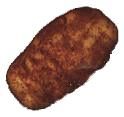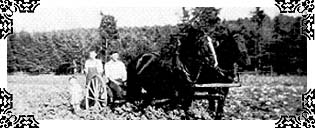








With
its rich soil and relatively short, damp growing season,
Prince Edward Island is practically tailor-made for the
cultivation of potatoes. The first settlers planted
potatoes because the hearty tubers would grow on the
newly-cleared land, thriving even when hand-planted
amongst the tree stumps. Much of the harvesting was also
done by hand, with pickers pulling the potato stalks and
gathering the tubers into baskets and bags. The field
would then be harrowed to expose the remaining potatoes.
While farmers today can take care of all their own
harvesting, thanks to mechanical harvesters and diggers,
farmers around the turn of the century had to hire teams
of potato pickers to help them get the crop in from the
field.
 Farmers had to
experiment with different varieties to discover which
strains were-- and were not-- suited to the soil. They
found, for instance, that the Irish Cobbler did not
produce a good yield and that MacIntyre Blues were
susceptible to blight. The Russet Burbank and Netted Gem
are two varieties which have flourished in the Island's
red fields.
Farmers had to
experiment with different varieties to discover which
strains were-- and were not-- suited to the soil. They
found, for instance, that the Irish Cobbler did not
produce a good yield and that MacIntyre Blues were
susceptible to blight. The Russet Burbank and Netted Gem
are two varieties which have flourished in the Island's
red fields.
In the late 1800s, potatoes began to emerge as an important cash crop on the Island. A regional export market opened up, and farmers began shipping their spuds to the lumberjacks of New Brunswick and the fishermen of Nova Scotia and Newfoundland. Soon, P.E.I. was starting to become known abroad as a potato capital. Potatoes were so plentiful that Island farmers also used them as pig feed, which in turn produced a thriving pork industry.
 But pigs certainly were
not the only occupants relying on potatoes for their
chief subsistence. During the Depression
years, when just about everything else was scarce,
potatoes were still abundant. One expression used to
characterize the Island diet during that era was
'potatoes and point.' If Islanders thought about any food
besides potatoes, in other words, they had better be
content with just pointing at it. While many might have
wished for a more flavorful meal, the point remains that
potatoes kept many stomachs full, stomachs that otherwise
might have stayed empty.
But pigs certainly were
not the only occupants relying on potatoes for their
chief subsistence. During the Depression
years, when just about everything else was scarce,
potatoes were still abundant. One expression used to
characterize the Island diet during that era was
'potatoes and point.' If Islanders thought about any food
besides potatoes, in other words, they had better be
content with just pointing at it. While many might have
wished for a more flavorful meal, the point remains that
potatoes kept many stomachs full, stomachs that otherwise
might have stayed empty.
The second half of the twentieth century has
seen the industry shift its focus to the seed potato
market. Famous for their quality, Island seed potatoes
are now shipped around the world. Perhaps other countries
hope that the charm of the
'Million Acre Farm' will rub off on them. Much of the
table stock is now grown for large potato processing
plants, which churn out millions of french fries each
day. While no one farms between the tree stumps anymore,
the potato continues to grow almost anywhere else it is
planted in our red soil.
